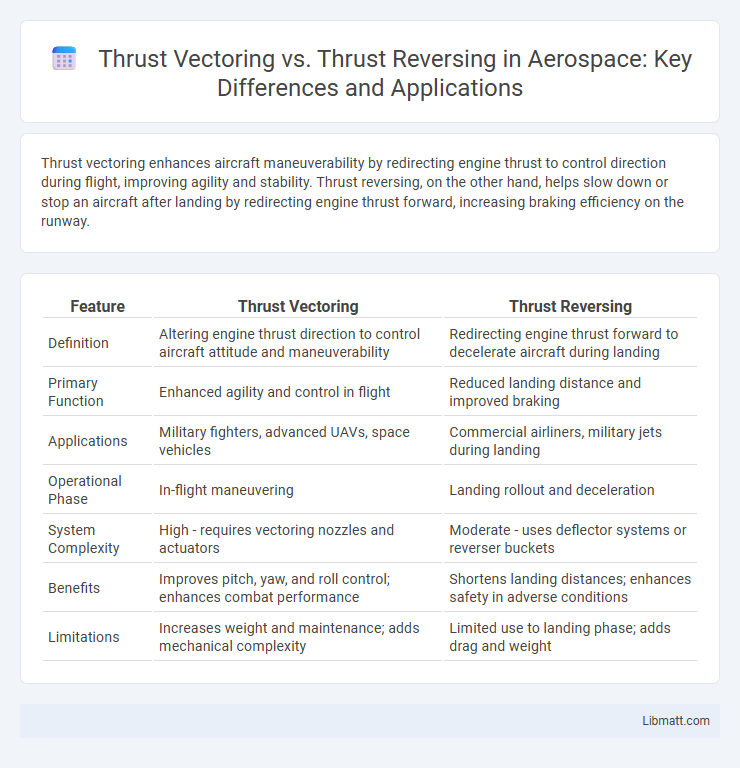Thrust vectoring enhances aircraft maneuverability by redirecting engine thrust to control direction during flight, improving agility and stability. Thrust reversing, on the other hand, helps slow down or stop an aircraft after landing by redirecting engine thrust forward, increasing braking efficiency on the runway.
Table of Comparison
| Feature | Thrust Vectoring | Thrust Reversing |
|---|---|---|
| Definition | Altering engine thrust direction to control aircraft attitude and maneuverability | Redirecting engine thrust forward to decelerate aircraft during landing |
| Primary Function | Enhanced agility and control in flight | Reduced landing distance and improved braking |
| Applications | Military fighters, advanced UAVs, space vehicles | Commercial airliners, military jets during landing |
| Operational Phase | In-flight maneuvering | Landing rollout and deceleration |
| System Complexity | High - requires vectoring nozzles and actuators | Moderate - uses deflector systems or reverser buckets |
| Benefits | Improves pitch, yaw, and roll control; enhances combat performance | Shortens landing distances; enhances safety in adverse conditions |
| Limitations | Increases weight and maintenance; adds mechanical complexity | Limited use to landing phase; adds drag and weight |
Introduction to Thrust Vectoring and Thrust Reversing
Thrust vectoring adjusts the direction of engine thrust to enhance aircraft maneuverability, allowing precise control during advanced flight maneuvers and improved stability. Thrust reversing redirects engine exhaust forward to decrease speed rapidly after landing, contributing to shorter runway requirements and safer deceleration. Your understanding of both technologies highlights their distinct roles in optimizing aircraft performance and safety during different flight phases.
Understanding Thrust Vectoring: How It Works
Thrust vectoring involves directing the engine's thrust in different directions to control an aircraft's attitude and improve maneuverability, especially in fighter jets and advanced aerospace vehicles. This system adjusts nozzle angles or uses movable vanes to redirect exhaust flow, enabling precise control of pitch, yaw, and roll without relying solely on traditional control surfaces. Unlike thrust reversing, which redirects thrust forward to decelerate an aircraft during landing, thrust vectoring primarily enhances flight dynamics and agility during various phases of flight.
Thrust Reversing Explained: Function and Mechanics
Thrust reversing is a critical aerodynamic mechanism primarily used to decelerate aircraft upon landing by redirecting engine thrust forward, opposing the forward motion. This is achieved through deployable panels or buckets in the engine's exhaust path, which alter the direction of the thrust flow, significantly enhancing braking efficiency and reducing runway length requirements. Understanding the function and mechanics of thrust reversing can help you appreciate how pilots safely and effectively manage landing speeds during critical flight phases.
Key Differences Between Thrust Vectoring and Thrust Reversing
Thrust vectoring changes the direction of engine thrust to enhance aircraft maneuverability and control during flight, enabling improved agility and stability. Thrust reversing redirects engine thrust forward to decelerate the aircraft upon landing, reducing runway distance and wear on brakes. While thrust vectoring optimizes in-flight performance, thrust reversing primarily assists in safe and efficient deceleration on the ground.
Applications of Thrust Vectoring in Modern Aviation
Thrust vectoring enhances maneuverability and control in advanced fighter jets like the F-22 Raptor and Sukhoi Su-57 by directing engine thrust to improve pitch, yaw, and roll. It enables superior agility during dogfights, short takeoffs, and vertical landings, significantly boosting combat performance. This technology is also utilized in experimental aircraft and next-generation drones to achieve enhanced aerodynamic efficiency and flight stability.
Thrust Reversing in Commercial and Military Aircraft
Thrust reversing technology in commercial aircraft primarily enhances landing performance by redirecting engine thrust forward, reducing runway length and improving safety during deceleration. Military aircraft utilize thrust reversers not only for landing assistance but also for rapid deceleration and enhanced maneuverability in tactical operations. Unlike thrust vectoring, which alters engine nozzle direction to control flight dynamics, thrust reversing focuses solely on improving braking efficiency through exhaust flow manipulation.
Advantages of Thrust Vectoring for Maneuverability
Thrust vectoring enhances aircraft maneuverability by directing engine thrust in multiple directions, allowing for tighter turns and improved control at low speeds or high angles of attack. This technology empowers pilots to execute advanced flight maneuvers with greater precision and stability, which is crucial in combat and aerobatic scenarios. Your aircraft can benefit from thrust vectoring by achieving superior agility without relying solely on traditional aerodynamic surfaces.
Benefits of Thrust Reversing for Safe Landings
Thrust reversing enhances aircraft safety by enabling shorter landing distances, reducing runway wear and improving control during deceleration. By redirecting engine thrust forward, pilots achieve more effective speed reduction without overreliance on wheel brakes, minimizing the risk of skidding on wet or icy runways. This critical function supports safer and more efficient aircraft recoveries, especially in adverse weather and emergency situations.
Technological Innovations in Thrust Control Systems
Thrust vectoring technology enables precise directional control of engine thrust by redirecting the exhaust flow, enhancing maneuverability and performance in modern aircraft and spacecraft. Thrust reversing systems, on the other hand, utilize mechanical deflectors or cascades to redirect engine thrust forward, primarily aiding in deceleration during landing phases. Your choice between these systems depends on aircraft design priorities and mission requirements, as ongoing innovations continuously improve responsiveness, efficiency, and integration with advanced flight control systems.
Future Trends: Integration of Thrust Vectoring and Reversing
Future trends in aerospace propulsion highlight the integration of thrust vectoring and thrust reversing technologies to enhance aircraft maneuverability and braking efficiency. Combining thrust vectoring's directional control with thrust reversing's deceleration capabilities enables more precise handling during critical flight phases such as landing and combat maneuvers. Advanced materials and control algorithms will drive the development of unified thrust management systems, improving overall aircraft performance and safety.
Thrust Vectoring vs Thrust Reversing Infographic

 libmatt.com
libmatt.com